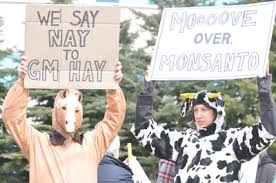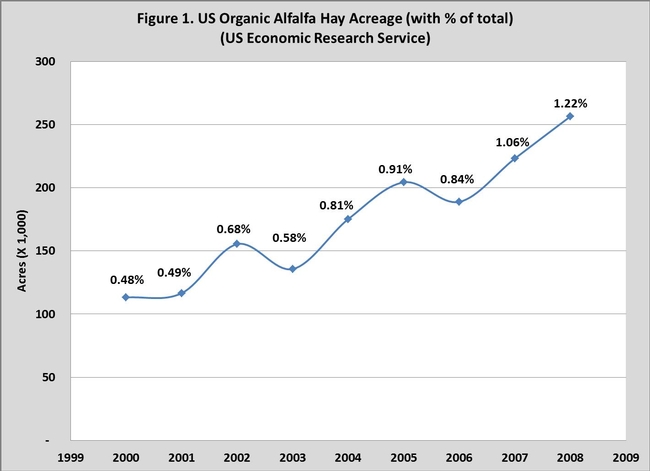New video and recent protests highlight controversy.
For those of you interested in the on-going public discussion about Genetically Engineered (GE) or Genetically Modified (GMO) foods, check out a new video produced for public television ‘The Next Meal: Genetically Engineered Foods’, airing tonight in San Francisco, and in May at other PBS stations. You can download it here:
http://science.kqed.org/quest/video/next-meal-engineering-food/
This video contains a full (and balanced) discussion of the science of genetic engineering itself, the possibility of genetic improvements to address drought and human health, as well as the some of the public objections to GE crops and the GMO labeling issue. 
|
Anti-GE alfalfa protests in Guelph, Canada, April 2013. Protesters claim that GMO alfalfa would threaten organic hay production. However, organic alfalfa has expanded dramatically since the introduction of Roundup-Ready Alfalfa in the US. |
Some quite inventive protests, as the video and above photo illustrate! Additionally, last month there were a number of protests in Canadian cities as our neighbors to the north consider deregulating Roundup-Ready (RR) alfalfa in Eastern Canada. Similar to the US situation, a number of farmers are interested in the RR Alfalfa technology, whereas some farmers and food activists are interested in preventing GMO technology from being commercialized.
But there are also some very intriguing possibilities for crop adaptation to drought and improvement in human nutrition through genetic engineering, as the PBS documentary points out.
For ‘Medicago-philes’ (look it up), this film prominently features ‘The Queen of Forages’, and California alfalfa grower Philip Bowles from Los Banos, CA. Philip and many California growers have planted large acreages of Roundup Ready alfalfa in California’s alfalfa fields, at this point likely over 50% of new statewide plantings. Roundup Ready alfalfa (genetically engineered) was originally approved in 2005, then taken off the market by a legal injunction, and finally approved in 2011 after 4 years of an Environmental Impact Study by USDA.
This video was released on the heels of the narrow loss in November 2012 of Proposition 37 in California, which would have required labeling of GMO foods—a hotly contested proposition. Although defeated, the initiative was supported by 6 million voters. Ironically, the major GMO crops currently grown in California: cotton, feed corn, and alfalfa would have been largely ignored by the proposed law. Cotton is not a food, and feed corn and alfalfa are largely used for dairy or other animal production, making them exempt from labeling requirements. Actually this is also true nationally: the vast majority of the GE crops are currently utilized in animal production, not directly consumed.
Albert Strauss, prominent Marin County, CA organic dairy producer, expressed his concerns in the film about GMO foods and GE alfalfa. He points out that his customers largely reject GMO foods.
Which raises a key point: Has the introduction of GMO alfalfa resulted in the disappearance of, or acted as a threat to, organic alfalfa or dairy production?
The evidence does not support this contention. Since the introduction of RR alfalfa in 2005, the production of organic alfalfa hay has increased by over 45% (Figure 1). Organic dairies have similarly thrived. Although it still represents less than 2% of national acreage, organic alfalfa has become more important in recent years. Idaho is the nation’s leading organic alfalfa hay state, and California produced over 18,000 acres of organic alfalfa in 2008 out of about 950,000 acres total (US Econ. Research Service Data).
In fact, it could be argued that the introduction of RR alfalfa may have strengthened the hand of organic producers to some degree, since it raises the awareness of the presence of GMOs in conventional milk production. It’s interesting that since 2005, both RR alfalfa, organic alfalfa, and export alfalfa (which is THE most important market sensitive to GMO alfalfa) have expanded dramatically in importance.
Which brings up the need for ‘Coexistence’ – respect for (and support for) all different types of agriculture, whether GE-adapting or GE-rejecting. More on that later. For some detailed discussion of the importance of co-existence and what the alfalfa industry is doing, see: http://alfalfa.ucdavis.edu and the National Alfalfa & Forage Alliance site www.alfalfa.org
But stay tuned, it looks like the controversy over GMO foods (and GE alfalfa) is not disappearing anytime soon. Farmers, consumers, and the public need to make sure they understand the technology, and remained engaged to make informed decisions.
